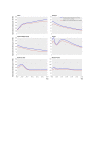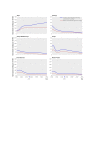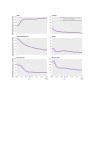Projected effects of tobacco smoking on worldwide tuberculosis control: mathematical modelling analysis
- PMID: 21972295
- PMCID: PMC3186817
- DOI: 10.1136/bmj.d5506
Projected effects of tobacco smoking on worldwide tuberculosis control: mathematical modelling analysis
Abstract
Objectives: Almost 20% of people smoke tobacco worldwide--a percentage projected to rise in many poor countries. Smoking has been linked to increased individual risk of tuberculosis infection and mortality, but it remains unclear how these risks affect population-wide tuberculosis rates.
Design: We constructed a state transition, compartmental, mathematical model of tuberculosis epidemics to estimate the impact of alternative future smoking trends on tuberculosis control. We projected tuberculosis incidence, prevalence, and mortality in each World Health Organization region from 2010 to 2050, and incorporated changing trends in smoking, case detection, treatment success, and HIV prevalence.
Results: The model predicted that smoking would produce an excess of 18 million tuberculosis cases (standard error 16-20) and 40 million deaths from tuberculosis (39-41) between 2010 and 2050, if smoking trends continued along current trajectories. The effect of smoking was anticipated to increase the number of tuberculosis cases by 7% (274 million v 256 million) and deaths by 66% (101 million v 61 million), compared with model predictions that did not account for smoking. Smoking was also expected to delay the millennium development goal target to reduce tuberculosis mortality by half from 1990 to 2015. The model estimated that aggressive tobacco control (achieving a 1% decrease in smoking prevalence per year down to eradication) would avert 27 million smoking attributable deaths from tuberculosis by 2050. However, if the prevalence of smoking increased to 50% of adults (as observed in countries with high tobacco use), the model estimated that 34 million additional deaths from tuberculosis would occur by 2050.
Conclusions: Tobacco smoking could substantially increase tuberculosis cases and deaths worldwide in coming years, undermining progress towards tuberculosis mortality targets. Aggressive tobacco control could avert millions of deaths from tuberculosis.
Conflict of interest statement
Conflicts of interest: All authors have completed the Unified Competing Interest form at
Figures




Comment in
-
Effects of particulate matter from global burning of biomass.BMJ. 2011 Nov 15;343:d7307. doi: 10.1136/bmj.d7307. BMJ. 2011. PMID: 22089738 No abstract available.
Similar articles
-
The global burden of tuberculosis: results from the Global Burden of Disease Study 2015.Lancet Infect Dis. 2018 Mar;18(3):261-284. doi: 10.1016/S1473-3099(17)30703-X. Epub 2017 Dec 7. Lancet Infect Dis. 2018. PMID: 29223583 Free PMC article.
-
Alternative projections of mortality and disability by cause 1990-2020: Global Burden of Disease Study.Lancet. 1997 May 24;349(9064):1498-504. doi: 10.1016/S0140-6736(96)07492-2. Lancet. 1997. PMID: 9167458
-
The potential effects of tobacco control in China: projections from the China SimSmoke simulation model.BMJ. 2014 Feb 18;348:g1134. doi: 10.1136/bmj.g1134. BMJ. 2014. PMID: 24550245 Free PMC article.
-
Tuberculosis.In: Holmes KK, Bertozzi S, Bloom BR, Jha P, editors. Major Infectious Diseases. 3rd edition. Washington (DC): The International Bank for Reconstruction and Development / The World Bank; 2017 Nov 3. Chapter 11. In: Holmes KK, Bertozzi S, Bloom BR, Jha P, editors. Major Infectious Diseases. 3rd edition. Washington (DC): The International Bank for Reconstruction and Development / The World Bank; 2017 Nov 3. Chapter 11. PMID: 30212088 Free Books & Documents. Review.
-
The impact of tobacco on lung health in China.Respirology. 2003 Mar;8(1):17-21. doi: 10.1046/j.1440-1843.2003.00433.x. Respirology. 2003. PMID: 12856737 Review.
Cited by
-
Perspectives of Hospital Staff on Barriers to Smoking Cessation Interventions among Drug-Resistant Tuberculosis Patients in a South African Management Hospital.Int J Environ Res Public Health. 2024 Aug 28;21(9):1137. doi: 10.3390/ijerph21091137. Int J Environ Res Public Health. 2024. PMID: 39338021 Free PMC article.
-
Cigarette Smoking as a Risk Factor for Tuberculosis in Adults: Epidemiology and Aspects of Disease Pathogenesis.Pathogens. 2024 Feb 7;13(2):151. doi: 10.3390/pathogens13020151. Pathogens. 2024. PMID: 38392889 Free PMC article. Review.
-
Prevalence, patterns, and factors associated with tobacco use among patients with priority tobacco related illnesses at four Kenyan national referral hospitals, 2022.PLOS Glob Public Health. 2023 Nov 10;3(11):e0002002. doi: 10.1371/journal.pgph.0002002. eCollection 2023. PLOS Glob Public Health. 2023. PMID: 37948351 Free PMC article.
-
High prevalence of current tobacco smoking among patients with tuberculosis and people living with HIV in Jordan: A cross-sectional survey.Tob Induc Dis. 2023 Oct 20;21:136. doi: 10.18332/tid/171551. eCollection 2023. Tob Induc Dis. 2023. PMID: 37869614 Free PMC article.
-
Is Tobacco Use Associated With Risk of Recurrence and Mortality Among People With TB?: A Systematic Review and Meta-Analysis.Chest. 2024 Jan;165(1):22-47. doi: 10.1016/j.chest.2023.08.021. Epub 2023 Aug 29. Chest. 2024. PMID: 37652295 Free PMC article.
References
-
- World Health Organization. The stop TB strategy—building on and enhancing DOTS to meet the TB-related Millennium Development Goals. WHO, 2006.
-
- Lonnroth K, Jaramillo E, Williams BG, Dye C, Raviglione M. Drivers of tuberculosis epidemics: the role of risk factors and social determinants. Soc Sci Med 2009;68:2240-6. - PubMed
-
- World Health Organization. Global tuberculosis control—surveillance, planning, financing. World Health Organization, 2008.
Publication types
MeSH terms
Grants and funding
LinkOut - more resources
Full Text Sources
Medical

